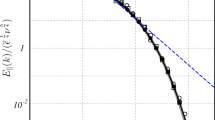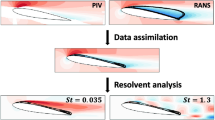Abstract
An experimental study was conducted on the wakes around three different obstacles confined between two parallel walls: semi-ellipsoids with the major axes of the base ellipses aligned in the streamwise and transverse directions, and a sphere. The Reynolds number was \(1.78 \times 10^4\) based on obstacle height, H. Common to each of these geometries is a convex surface of the obstacle intersecting one or more boundaries, which was shown to result in a wall jet in the vicinity of the junction. Large streamwise counter-rotating vortex structures were found to be a robust feature of the wakes, which are referred to as lobes, due to their resemblance to previously coined lobe structures identified in the wake of a deeply submerged sphere. Inner lobe structures, of opposite sense to the primary lobes, were also observed in all cases, and it is proposed that the primary and inner lobe structures are formed by the wall jet deforming vorticity shed by the obstacle into a hairpin-like loop. Wavelet analysis of velocity time series on both sides of the wake revealed approximately antisymmetric vortex shedding in the ellipsoid wakes; however, intermittent in-phase shedding was observed in the wake of the sphere. This study showed that the shape of the obstacle junction (convex vs. flat) plays an important role in the behavior of the wake.
















Similar content being viewed by others
Data availability
Some or all data, models or code that support the findings of this study are available from the corresponding author upon reasonable request.
Abbreviations
- f :
-
Frequency of velocity fluctuations in the wake, Hz
- H :
-
Obstacle height, mm
- D :
-
Maximum transverse dimension, mm
- AR:
-
Aspect ratio, \(\text{AR} = H/D\)
- \(U_{\infty }\) :
-
Free-stream velocity, m/s
- d :
-
Flow depth, mm
- RS:
-
Relative submergence, the ratio of flow depth to obstacle height
- x, y, z :
-
streamwise, transverse and spanwise (vertical) directions
- \(\omega\) :
-
Vorticity, s−1
- \(\omega ^*\) :
-
Dimensionless vorticity, \(\omega ^*= \omega D / U_{\infty }\)
- \(\Gamma\) :
-
Circulation, mm2/s
- \(\Gamma ^*\) :
-
Dimensionless circulation, \(\Gamma ^* = \Gamma /(U_{\infty }D)\)
- \(\text{Re}_H\) :
-
Reynolds number, \(\text{Re}_H = \frac{U_{\infty } H}{\nu }\)
- \(\nu\) :
-
Kinematic viscosity, m2/s
- \(f^*\) :
-
Dimensionless frequency, \(f^*=f D/U_{\infty }\)
- \(f_{0}\) :
-
Dominant frequency
- St:
-
Strouhal number, \(St = f_{0} D/U_{\infty }\)
References
Addison PS (2002) The illustrated wavelet transform handbook: introductory theory and applications in science. Taylor and Francis, Boca Raton, Engineering, Medicine and Finance, 2nd edn. https://doi.org/10.1201/9781315372556
Sayed Ahmed S, Mesalhy OM, Abdelatief MA (2015) Flow and heat transfer enhancement in tube heat exchangers. Heat Mass Transfer 51:1607–1630. https://doi.org/10.1007/s00231-015-1669-1
Bhuiyan AA, Sadrul Islam AKM (2016) Thermal and hydraulic performance of finned-tube heat exchangers under different flow ranges: a review on modeling and experiment. Int J Heat Mass Trans 101:38–59. https://doi.org/10.1016/j.ijheatmasstransfer.2016.05.022
Bourgeois J (2012) Three-dimensional topology and dynamical modelling of vortex shedding from finite surface-mounted bluff bodies. PhD thesis, University of Alberta, Canada
Bourgeois JA, Sattari P, Martinuzzi RJ (2011) Alternating half-loop shedding in the turbulent wake of a finite surface-mounted square cylinder with a thin boundary layer. Phys Fluids 23(095101):1–14
Cao Y, Tamura T, Zhou D, Bao Y, Han Z (2022) Topological description of near-wall flows around a surface-mounted square cylinder at high Reynolds numbers. J Fluid Mech. https://doi.org/10.11017/jfm.2021.1043
Crane R, Popinhak A, Martinuzzi R, Morton C (2022) Tomographic piv investigation of vortex shedding topology for a cantilevered circular cylinder. J Fluid Mech. https://doi.org/10.11017/jfm.2021.904
da Silva BL, Chakravarty R, Sumner D, Bergstrom DJ (2020) Vortex dynamics of a low aspect ratio cantilevered cylinder immersed in a boundary layer. Int J Heat Fluid Flow 83:108569. https://doi.org/10.1016/j.ijheatfluidflow.2020.108569
Essel EE, Tachie MF, Balachandar R (2021) Time-resolved wake dynamics of finite wall-mounted circular cylinders submerged in a turbulent boundary layer. J Fluid Mech. https://doi.org/10.11017/jfm.2021.265
Fischenich C, Seal R (1999) Boulder clusters. In: EMRRP technical notes collection (ERDC TN-EMRRP-SR-11U.S. Army engineer research and development center, p 1–6
Gildersleeve S, Amitay M (2020) Vortex dynamics of a low aspect ratio cantilevered cylinder immersed in a boundary layer. J Fluid Mech 901:18. https://doi.org/10.11017/jfm.2020.555
Goswami S, Hemmati A (2020) Response of turbulent pipeflow to multiple square bar roughness elements at high reynolds number. Phys Fluids 32:075110. https://doi.org/10.1063/5.0014832
Grossman A, Morlet J (1985) Decompositions of functions into wavelets of constant shape and related transforms: mathematics and physics, lecture on recent results. World Scientific Publishing, Singapore. https://doi.org/10.1142/9789814415125_0004
Hain R, Kahler CJ, Michaelis D (2008) Tomographic and time resolved piv measurements on a finite cylinder mounted on a flat plate. Exp Fluids 45:715–724. https://doi.org/10.1007/s00348-008-0553-x
Hajimirzaie SM (2013) Flow structure in the wake of a low-aspect-ratio wall-mounted bluff body. PhD thesis, University of Iowa, USA
Hajimirzaie SM, Buchholz JHJ (2013) Flow dynamics in the wakes of low-aspect-ratio wall-mounted obstacles. Exp Fluids 54:1616–1630. https://doi.org/10.1007/s00348-013-1616-1
Hajimirzaie SM, Wojcik CJ, Buchholz JHJ (2012) The role of shape and relative submergence on the structure of wakes of low-aspect-ratio wall-mounted bodies. Exp Fluids 53:1943–1962. https://doi.org/10.1007/s00348-012-1406-1
Hajimirzaie SM, Tsakiris AG, Buchholz JHJ, Papanicolaou AN (2014) Flow characteristics of a wall-mounted sphere. Exp Fluids 55:1762–1776. https://doi.org/10.1007/s00348-014-1762-0
Hosseini Z, Bourgeois J, Martinuzzi R (2013) Large-scale structures in dipole and quadrupole wakes of a wall-mounted finite rectangular cylinder. Exp Fluids 54:1595–1611. https://doi.org/10.1007/s00348-013-1595-2
Hunt JCR, Abell CJ, Peterka JA, Woo H (1978) Kinematical studies of the flows around free or surface-mounted obstacles. J Fluid Mech 86:179–200. https://doi.org/10.1017/S0022112078001068
Jang JY, Wu MC, Chang WJ (1996) Numerical and experimental studies of three-dimensional plate fin-and-tube heat exchangers. Int J Heat Mass Transf 39:3057–3066. https://doi.org/10.1016/0017-9310(95)00341-X
Jia Y, Punithakumar K, Noga M, Hemmati A (2021) Blood flow manipulation in the aorta with coarctation and arch narrowing for pediatric subjects. J Appl Mech 88:021001. https://doi.org/10.1063/5.0014832
Kourta A, Boisson H, Chassing P, Ha Minh H (1987) Non-linear interactions and the transition to turbulence in the wake of a circular cylinder. J Fluid Mech 181:141–161. https://doi.org/10.1017/S0022112087002039
Meinders ER, Hanjalic K (2002) Experimental study of convective heat transfer from in-lined and staggered configurations of two wall-mounted cubes. Int J Heat Mass Transf 45:465–482. https://doi.org/10.1016/S0017-9310(01)00180-6
Mi J, Xu M, Antonia RA, Wang JJ (2011) Thermal characteristics of the wake shear layers from a slightly heated circular cylinder. Exp Fluids 50:429–441. https://doi.org/10.1007/s00348-010-0944-7
Narasimha R, Prasad SN (1994) Leading edge shape for flat plate boundary layer studies. Exp Fluids 17:358–360. https://doi.org/10.1007/BF01874418
Nguyen QD, Lei C (2023) A PIV study of blockage ratio effects on flow over a confined circular cylinder at low Reynolds numbers. Exp Fluids 64:10. https://doi.org/10.1007/s00348-022-03548-w
Okamoto S, Sunabashiri Y (1992) Vortex shedding from a circular cylinder of finite length placed on a ground plane. ASME J Fluids Eng 112:512–521
Ozturk NA, Akkoca A, Sahin B (2008) PIV measurements of flow past a confined cylinder. Exp Fluids 44:1001–1014. https://doi.org/10.1007/s00348-007-0459-z
Papanicolaou AN, Kramer C (2005) The role of relative submergence on cluster microtopography and bedload predictions on mountain streams. In: Proceedings Int Symposium River, Coastal and Estuarine Morphodynamics 4–7, (October 2005) Urbana. USA, Taylor and Francis, Philadephia., p
Papanicolaou AN, Kramer C, Tsakiris A, Stoesser T, Bomminayuni S, Chen Z (2012) Effects of a fully submerged boulder within a boulder array on the mean and turbulent flow fields: implications to bedload transport. Acta Geophysica. https://doi.org/10.2478/s11600-012-0044-6
Pattenden RJ, Turnock SR, Zhang Z (2005) Measurements of the flow over a low-aspect-ratio cylinder mounted on a ground plane. Exp Fluids 39:10–21. https://doi.org/10.1007/s00348-005-0949-9
Porteous R, Moreau D, Doolan C (2014) A review of flow-induced noise from finite wall-mounted cylinders. J Fluids Struct 51:240–254. https://doi.org/10.1016/j.jfluidstructs.2014.08.012
Porteous R, Moreau D, Doolan C (2017) The aeroacoustics of finite wall-mounted square cylinders. J Fluids Mech 832:287–328. https://doi.org/10.11017/jfm.2017.682
Rajagopalan S, Antonia RA (2005) Flow around a circular cylinder-structure of the near wake shear layer. Exp Fluids 38:393–402. https://doi.org/10.1007/s00348-004-0913-0
Rastan MR, Sohankar A, Alam MM (2017) Low-reynolds-number flow around a wall-mounted square cylinder: flow structures and onset of vortex shedding. Phys Fluids 29:103601. https://doi.org/10.1063/1.4989745
Rockwell D (2008) Vortex formation in shallow flows. Phys Fluids 20:031303
Sakamoto H, Arie M (1983) Vortex shedding from a rectangular prism and a circular cylinder placed vertically in a turbulent boundary layer. J Fluid Mech 126:147–165. https://doi.org/10.1017/S0022112083000087
Sattari P, Bourgeois JA, Martinuzzi RJ (2010) Turbulent wake of surface-mounted finite aspect ratio bluff bodies. In: ASME conference proceedings 1(30811)
Sattari P, Bourgeois JA, Martinuzzi RJ (2012) On the vortex dynamics in the wake of a finite surface-mounted square cylinder. Exp Fluids 52:1149–1167. https://doi.org/10.1007/s00348-011-1244-6
Sau A, Hwang RR, Sheu TWH, Yang WC (2003) Interaction of trailing vortices in the wake of a wall-mounted rectangular cylinder. Phys Rev E 68:056303. https://doi.org/10.11103/PhysRevE.68.056303
Shamloo H, Rajaratman N, Katopodis C (2001) Hydraulics of simple habitat structures. J Hydraulic Res 39(4):351–366. https://doi.org/10.1080/00221680109499840
Strom KB, Papanicolaou AN (2007) ADV measurements around a cluster microform in a shallow mountain stream. J Hydraulic Eng 133(12):1379–1389. https://doi.org/10.1061/(ASCE)0733-9429(2007)133:12(1379)
Sumner D (2013) Flow above the free end of a surface-mounted finite-height circular cylinder: a review. J Fluids Struct 43:41–63. https://doi.org/10.1016/j.jfluidstructs.2013.08.007
Sumner D, Heseltine JL, Dansereau OJP (2004) Wake structure of a finite circular cylinder of small aspect ratio. Exp Fluids 37:720–730
Tsakiris AG (2014) Turbulent flow patterns around variably submerged boulders in mountain streams and implications to bedload transport. PhD thesis, University of Iowa, USA
Tsakiris AG, Papanicolaou AN, Hajimirzaie SM, Buchholz JHJ (2014) Influence of collective boulder array on the surrounding time-averaged and turbulent flow fields. J Mount Sci 11(6):1420–1428. https://doi.org/10.1007/s11629-014-3055-8
Uffinger T, Ali I, Becker S (2013) Experimental and numerical investigations of the flow around three different wall-mounted cylinder geometries of finite length. J Wind Engng Ind Aerodyn 119:13–27. https://doi.org/10.1016/j.jweia.2013.05.006
Walker JS (2008) A primer on wavelets and their scientific applications. Chapman and Hall-CRC, New York. https://doi.org/10.1201/9781584887461
Wang HF, Lam KM (2019) Geometry effects on mean wake topology and large-scale coherent structures of wall-mounted prisms. Phys Fluids 31:125109. https://doi.org/10.11063/1.5126045
Wang HF, Zhou Y (2009) The finite-length square cylinder near wake. J Fluid Mech 638:453–490
Westerweel J (2000) Theoretical analysis of the measurement precision in particle image velocimetry. Exp Fluids 29:S3–S12
Yauwenas Y, Porteous R, Moreau D, Doolan C (2019) The effect of aspect ratio on the wake structure of finite wall-mounted square cylinders. J Fluid Mech 875:929–960. https://doi.org/10.11017/jfm.2019.522
Zargar A, Goswami S, Hemmati A (2022) On the wake of a large depth ratio wall-mounted prism at a normal incident angle. J Wind Eng Ind Aerodyn 230:105168. https://doi.org/10.1016/j.jweia.2022.105168
Zargar A, Tarokh A, Hemmati A (2022) The unsteady wake transition behind a wall-mounted large-depth-ratio prism. J Fluid Mech 952:A12. https://doi.org/10.11017/jfm.2022.877
Zhu H, Wang C, Wang H, Wang J (2017) Tomographic PIV investigation on 3d wake structures for flow over a wall-mounted short cylinder. J Fluid Mech 831:743–778. https://doi.org/10.11017/jfm.2017.647
Funding
This work was supported by the United States National Science Foundation under award number CBET-1033732.
Author information
Authors and Affiliations
Corresponding author
Ethics declarations
Conflict of interest
The authors have no competing interests.
Ethical approval
Not applicable.
Additional information
Publisher's Note
Springer Nature remains neutral with regard to jurisdictional claims in published maps and institutional affiliations.
Rights and permissions
Springer Nature or its licensor (e.g. a society or other partner) holds exclusive rights to this article under a publishing agreement with the author(s) or other rightsholder(s); author self-archiving of the accepted manuscript version of this article is solely governed by the terms of such publishing agreement and applicable law.
About this article
Cite this article
Hajimirzaie, S.M., Buchholz, J.H.J. Flow patterns around confined low-aspect-ratio obstacles. Exp Fluids 64, 139 (2023). https://doi.org/10.1007/s00348-023-03675-y
Received:
Revised:
Accepted:
Published:
DOI: https://doi.org/10.1007/s00348-023-03675-y




